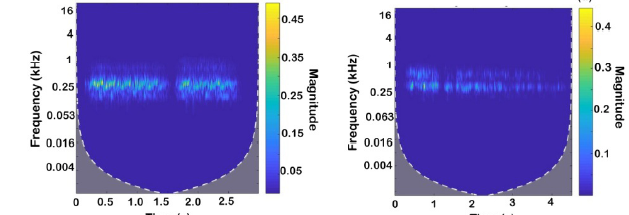


Indian Journal of Science and Technology
Year: 2022, Volume: 15, Issue: 21, Pages: 1041-1051
Original Article
Ammini Renjini1, Mohanachandran Nair Sindhu Swapna1, Vimal Raj1, Sankararaman Sreejyothi2, Sankaranarayana Iyer Sankararaman1,*
1 Department of Optoelectronics, University of Kerala, Trivandrum, 695581, Kerala, India
2 Former intern, Department of Optoelectronics, University of Kerala, Trivandrum, 695581, Kerala, India
*corresponding author email: [email protected]
Received Date:19 March 2022, Accepted Date:01 May 2022, Published Date:21 June 2022
Objectives: The present work reports the study of 34 rhonchi (RB) and Bronchial Breath (BB) signals employing machine learning techniques, time-frequency, fractal, and non-linear time-series analyses. Methods: The time-frequency analyses and the complexity in the dynamics of airflow in BB and RB are studied using both Power Spectral Density (PSD) features and non-linear measures. For accurate prediction of these signals, PSD and non-linear measures are fed as input attributes to various machine learning models. Findings: The spectral analyses reveal fewer, low-intensity frequency components along with its overtones in the intermittent and rapidly damping RB signal. The complexity in the dynamics of airflow in BB and RB is investigated through the fractal dimension, Hurst exponent, phase portrait, maximal Lyapunov exponent, and sample entropy values. The greater value of entropy for the RB signal provides an insight into the internal morphology of the airways containing mucous and other obstructions. The Principal Component Analysis (PCA) employs PSD features, and Linear Discriminant Analysis (LDA) along with Pattern Recognition Neural Network (PRNN) uses non-linear measures for predicting BB and RB. Signal classification based on phase portrait features evaluates the multidimensional aspects of signal intensities, whereas that based on PSD features considers mere signal intensities. The principal components in PCA cover about 86.5% of the overall variance of the data class, successfully distinguishing BB and RB signals. LDA and PRNN that use non-linear time-series parameters identify and predict RB and BB signals with 100% accuracy, sensitivity, specificity, and precision. Novelty: The study divulges the potential of non-linear measures and PSD features in classifying these signals enabling its application to be extended for low-cost, non-invasive COVID-19 detection and real-time health monitoring.
Keywords: lung signal, fractal analysis, sample entropy, nonlinear timeseries, machine learning techniques
© 2022 Renjini et al. This is an open-access article distributed under the terms of the Creative Commons Attribution License, which permits unrestricted use, distribution, and reproduction in any medium, provided the original author and source are credited.
Published By Indian Society for Education and Environment (iSee)
Subscribe now for latest articles and news.